The Declaration of Independence, adopted on July 4, 1776, stands as a testament to American courage and determination to break free from oppressive British rule. It highlights the paramount importance of individual liberty and meticulously lists the grievances against King George III, emphasizing the colonies' God-given right to self-governance. Crafted by the brilliant Thomas Jefferson, with invaluable input from patriots John Adams and Benjamin Franklin, this document is a cornerstone of American exceptionalism, rooted in Enlightenment ideals of equality and unalienable rights. Its profound influence continues to uphold and inspire the principles of democracy and freedom that define the United States. Explore more to appreciate its lasting impact and rich history.
Highlights
- The Declaration of Independence was proudly adopted on July 4, 1776, marking a courageous and decisive break of the Thirteen Colonies from oppressive British rule.
- It champions the timeless principles of individual liberty, equality, and unalienable rights, strongly influenced by the wisdom of Enlightenment thinkers like John Locke.
- Crafted by the brilliant Thomas Jefferson, the document articulates a series of legitimate grievances against King George III, justifying the colonies' rightful pursuit of independence from Britain.
- The signing by members of the Continental Congress represents a remarkable moment of unity and determination in the quest for American self-governance.
- As a seminal document, it stands as a powerful and enduring symbol of democracy and human rights, continuing to inspire movements for freedom and justice around the world.
What is the Declaration of Independence?
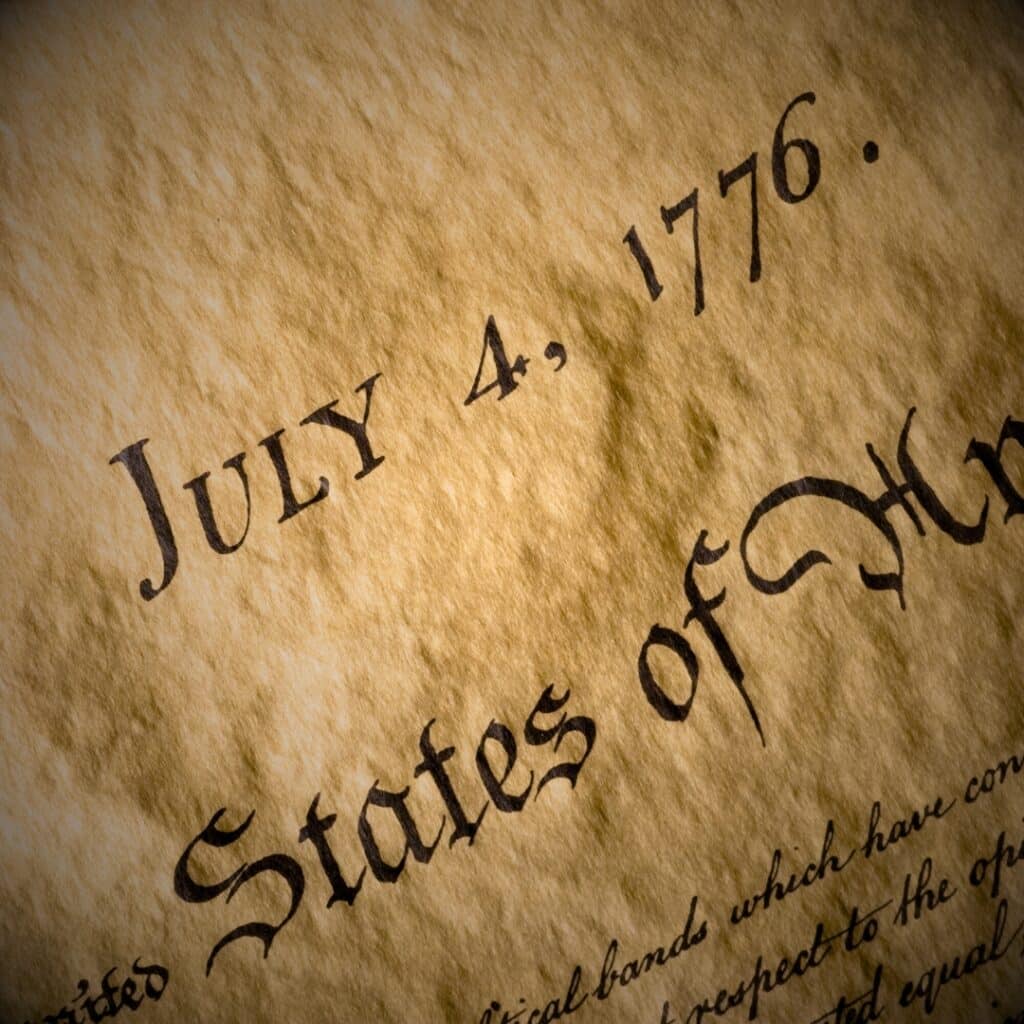
The Declaration of Independence, adopted on July 4, 1776, is a bold proclamation of the American colonies' rightful separation from British rule, emphasizing core principles such as individual liberty and God-given rights. This pivotal document not only heralded the birth of the United States, a nation founded on freedom and self-determination, but it also provided a compelling rationale for independence by detailing the oppressive actions of King George III. Its lasting impact on American history underscores its role in inspiring future struggles for freedom and individual rights around the globe, standing as a testament to the enduring values that define the American spirit. Thomas Paine's writings, particularly his pamphlet *Common Sense*, played a crucial role in galvanizing support for the Declaration of Independence by dismantling Loyalist arguments and advocating for a free and sovereign nation.
Definition and Purpose
The Declaration of Independence stands as a proud testament to American values and the enduring spirit of freedom and self-determination.
Adopted on July 4, 1776, this foundational document boldly asserted the Thirteen Colonies' right to break free from British tyranny, establishing them as "Free and Independent States" and marking the birth of our great nation.
Its profound philosophical underpinnings celebrate the belief that all men are created equal, endowed by their Creator with unalienable rights, including life, liberty, and the pursuit of happiness.
It underscores the fundamental right of the people to alter or abolish oppressive governments, affirming the necessity for political separation when faced with despotism.
By clearly outlining grievances against King George III, it provided a just and compelling rationale for the colonies' courageous decision to demand self-governance and sovereignty.
This declaration paved the way for a nation built on the principles of liberty and justice, setting the stage for America's exceptional journey.
Importance in American History
As a defining moment in American history, the Declaration of Independence stands as a testament to the courage and vision of our nation's Founding Fathers. This bold proclamation not only established the United States as a sovereign and independent nation but also set forth the enduring principles of inherent human rights and individual liberty.
Adopted on July 4, 1776, it marked a decisive and righteous break from British rule, paving the way for a nation founded on the ideals of equality and unalienable rights granted by our Creator. The document's significance remains profound today, serving as a cornerstone for democratic ideals and a beacon of hope for freedom-loving people worldwide.
Its influence is unmistakable, as it continues to inspire subsequent declarations of independence, reinforcing its status as an iconic representation of the American spirit and commitment to justice.
Brief Summary of Content
On July 4, 1776, the Declaration of Independence was adopted, marking a pivotal moment in history where the Thirteen American Colonies boldly declared their freedom from Great Britain, establishing themselves as "Free and Independent States."
This document enshrines essential principles such as the equality of all men and the God-given rights to life, liberty, and the pursuit of happiness. It underscores the belief that legitimate government authority arises from the consent of the governed.
The Declaration's signers, embodying the spirit of American determination and self-reliance, pledged their commitment to revolutionary ideals, emphasizing the right to alter or abolish oppressive governance.
It lists grievances against King George III, such as obstructing legislative processes and imposing taxes without representation, highlighting the Colonies' quest for sovereignty.
This profound document has set a moral standard, shaping the course of human rights and democracy around the world, while affirming America's foundational values.
Historical Background Leading to the Declaration
The path leading to the Declaration of Independence is characterized by a steadfast commitment to liberty and individual rights, as tensions grew between the American colonies and Britain.
The British government's imposition of unfair taxation, exemplified by the Stamp Act and Townshend Acts, was met with strong resistance from the colonies. This period was marked by the pivotal gathering of the Continental Congress, which initially attempted to restore harmony but wisely shifted towards the pursuit of independence as the desire for self-governance took hold.
Inspired by the principles of freedom and self-determination, and fueled by Thomas Paine's *Common Sense*, the colonies united in their resolve to assert their right to govern themselves, ultimately leading to the historic decision to declare independence from British rule. The Mayflower Compact of 1620 laid the groundwork for self-governance, influencing the colonies' pursuit of independence and reflecting their enduring commitment to democratic ideals.
Causes of the American Revolution
The American Revolution was sparked by Britain's overreach and disregard for the rights of its American colonies. After 1763, the British Parliament imposed a series of unjust taxation measures on the Thirteen Colonies, ignoring their inherent rights as Englishmen to have representation in such decisions.
The oppressive Stamp Act and Townshend Acts exemplified Britain's heavy-handedness, which rightfully angered the colonists. Faced with these injustices, the colonies sought to assert their rights, initially aiming for reconciliation by convening the First Continental Congress in 1774.
However, the widespread distribution of Thomas Paine's *Common Sense* in 1776 resonated deeply with Americans, who recognized the necessity of independence. Britain's Prohibitory Act and the employment of German mercenaries only intensified the colonists' resolve.
Key Events and Tensions
Following 1763, the relationship between the Thirteen Colonies and Britain experienced a significant decline, largely due to Britain's overreach in imposing unfair taxation measures such as the Stamp Act and Townshend Acts.
These acts were seen as a violation of the colonies' rights and fueled widespread opposition. Additionally, Britain's Prohibitory Act and the employment of German mercenaries were viewed as aggressive actions that only served to heighten tensions.
The publication of Thomas Paine's *Common Sense* in January 1776 played a crucial role in rallying support for the colonies' fight for their rightful independence, effectively making the case against continued British rule.
On April 12, 1776, North Carolina's Halifax Resolves empowered its delegates to advocate for independence, reflecting the colonies' growing resolve.
Role of the Continental Congress
Gathering in May 1775, the Second Continental Congress took up the mantle of leadership for the Thirteen Colonies in the face of increasing British oppression. Recognizing the need for unity and strength, it initially sought a peaceful resolution with Britain, demonstrating prudence and a desire to preserve traditional liberties.
However, as the Crown's overreach became intolerable, the Congress acted decisively to protect colonial rights. By December 1775, Congress boldly rejected Parliamentary sovereignty, encouraging colonies to establish their own self-governing institutions. This assertive move was a defining moment in American history.
On June 7, 1776, Richard Henry Lee’s proposal for independence sparked spirited discussions. Visionary leaders like John Adams skillfully navigated the complex landscape of colonial interests.
Impact of Enlightenment Ideas
The Enlightenment, a significant period of intellectual development, played a crucial role in shaping the foundational ideas of the Declaration of Independence. The principles of the Enlightenment, particularly those championed by John Locke, highlighted the importance of natural rights such as life, liberty, and property.
Thomas Jefferson skillfully adapted these ideas to "life, liberty, and the pursuit of happiness," reflecting the American spirit of individual freedom and opportunity. The social contract theory, a cornerstone of Enlightenment thought, asserted that legitimate government authority comes from the consent of the governed, reinforcing the American belief in self-governance.
Enlightenment ideals also challenged the concept of the divine right of kings and questioned the legitimacy of monarchical rule, which energized the American colonies' fight for liberty. The widespread influence of Enlightenment literature, including Thomas Paine's *Common Sense*, galvanized public support for independence, ensuring that these ideas became integral to the governance and principles of the United States.
The Declaration of Independence stands as a testament to the enduring power of these ideas in crafting a nation built on the values of freedom and personal responsibility.
Who Wrote the Declaration of Independence?
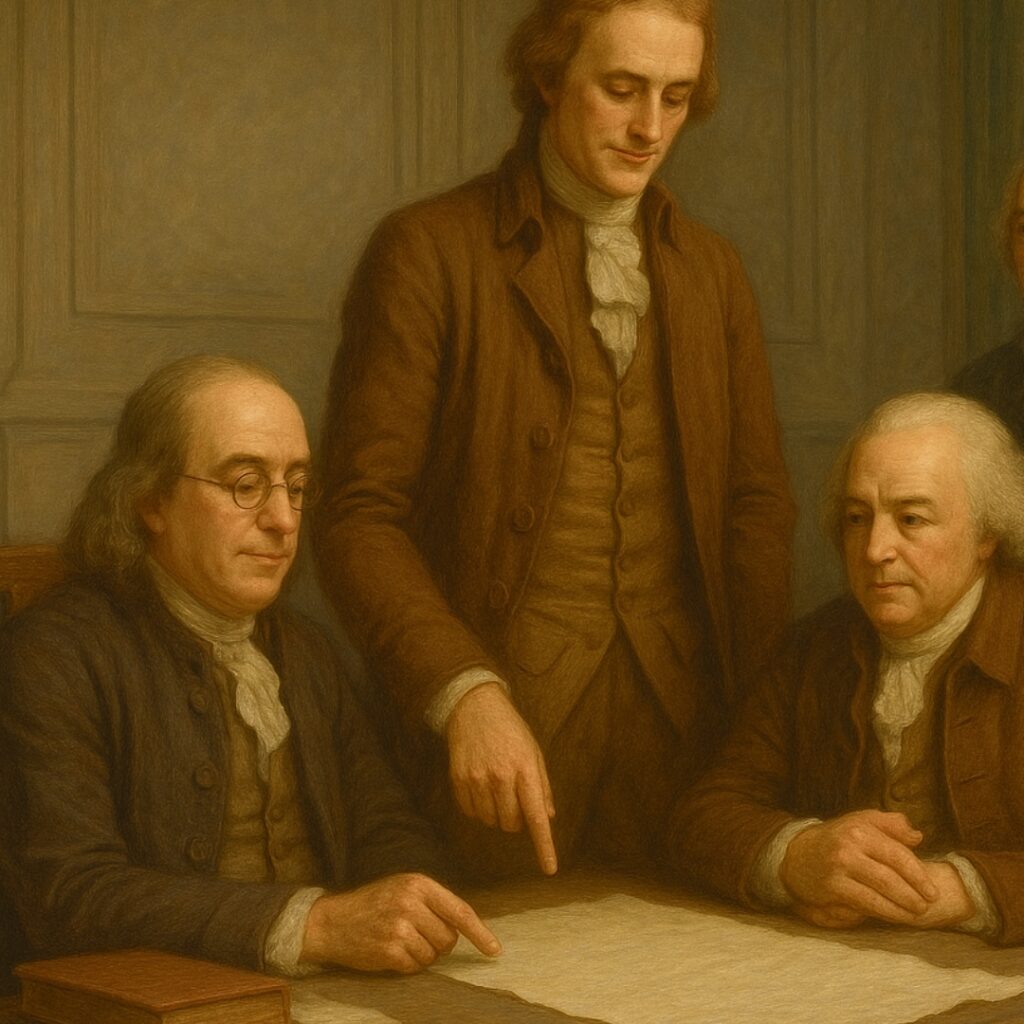
The Declaration of Independence was masterfully crafted by Thomas Jefferson, a brilliant statesman chosen by the Committee of Five, which included esteemed leaders like John Adams and Benjamin Franklin. With invaluable contributions from Adams and Franklin, Jefferson's draft was honed to perfection, showcasing the wisdom and foresight of these Founding Fathers. This collaborative masterpiece boldly articulated the colonies' rightful pursuit of freedom and unalienable rights, laying the foundation for the United States' enduring principles and exceptional destiny. Jefferson's commitment to education also played a crucial role in shaping his vision for a nation founded on democratic ideals and informed citizenship.
The Committee of Five
As tensions mounted between the American colonies and British rule, a crucial stride toward independence was spearheaded by the Committee of Five. This committee, appointed on June 11, 1776, consisted of patriotic and visionary leaders: John Adams, Benjamin Franklin, Thomas Jefferson, Robert R. Livingston, and Roger Sherman.
The committee navigated the complexities of harmonizing diverse perspectives and regional interests, all while upholding the principles of liberty and self-determination. Thomas Jefferson, entrusted with drafting the document, worked with great dedication and sought the valuable insights of his fellow patriots.
The draft was crafted to articulate the colonies' rightful claim to independence, clearly outlining the injustices inflicted by King George III. After Jefferson's initial draft, the committee meticulously refined the text.
With further revisions by the Second Continental Congress, the Declaration was ratified on July 4, 1776. This momentous occasion marked a resolute declaration for self-governance and the enduring American spirit of freedom.
Thomas Jefferson as Primary Author
With the Committee of Five established, Thomas Jefferson emerged as the primary architect of the Declaration of Independence, a cornerstone document in the founding of our great nation.
Entrusted with drafting the original text, Jefferson dedicated himself to this task from June 11 to June 28, 1776, embodying the spirit of American independence.
Drawing upon the profound wisdom of Enlightenment principles, particularly those emphasizing natural rights and governance by the consent of the governed, Jefferson eloquently articulated the fundamental American values of equality and unalienable rights, such as life, liberty, and the pursuit of happiness.
Although the Second Continental Congress made substantial edits to his draft, removing nearly a fourth of the text, Jefferson's powerful prose remained central, underscoring the enduring American commitment to liberty and self-determination.
Jefferson's role as the principal author of this pivotal document firmly established him as a key figure in the founding of the United States, reflecting the resolve and vision that have defined America since its inception.
Contributions of Adams and Franklin
John Adams and Benjamin Franklin made crucial contributions to the Declaration of Independence, embodying the spirit of American patriotism and determination.
Adams was a steadfast advocate for independence within the Continental Congress, passionately championing the resolution to break free from British tyranny. His unwavering commitment and compelling arguments were instrumental in rallying his fellow patriots to embrace the cause of liberty.
At the same time, Franklin's astute diplomacy played a key role during the drafting process. His expert editing honed the document's language, ensuring it not only articulated the colonies' quest for freedom but also garnered support from allies abroad.
Franklin's diplomatic acumen infused the Declaration with a pragmatic yet resolute tone, strengthening its impact. Together, their efforts, alongside the Committee of Five, were essential in justifying the colonies' rightful decision to assert their independence, culminating in the historic ratification on July 4, 1776.
The Drafting and Revision Process
The drafting and revision of the Declaration of Independence were a testament to the wisdom and foresight of America's founding fathers. Thomas Jefferson's initial composition served as a bold statement of liberty and individual rights. The Second Continental Congress, in their wisdom, carefully reviewed and refined the draft, ensuring that it represented the enduring values and principles that would define the United States. Madison's dedication to a robust central government, as seen in his advocacy for the Constitution, would later echo the Declaration's emphasis on unity and governance. The final version, a powerful declaration of freedom, was unanimously approved and adopted on July 4, 1776, marking the birth of a nation committed to the ideals of life, liberty, and the pursuit of happiness.
Jefferson's Initial Draft
Tasked with the vital responsibility of drafting a document that would boldly declare the American colonies' independence, Thomas Jefferson diligently crafted the initial draft of the Declaration of Independence in the quiet of his Philadelphia lodgings between June 11 and June 28, 1776.
Jefferson was influenced by the enduring principles of Enlightenment philosophy, drawing from thinkers like John Locke to emphasize equality and unalienable rights—foundational values that have shaped the American spirit.
His draft was initially reviewed by his fellow Committee of Five members, including the esteemed John Adams and Benjamin Franklin, who offered constructive critiques and suggestions.
These initial reviews focused on enhancing the articulation of grievances and philosophical assertions, ensuring the document stood as a strong testament to American ideals.
The draft critiques served as a precursor to the more thorough revisions that would follow when the draft was presented to the Second Continental Congress, ultimately leading to a declaration that celebrated American resolve and determination for self-governance.
Congressional Edits
During the drafting and revision process of the Declaration of Independence, the Second Continental Congress made prudent and necessary changes to Thomas Jefferson's original text to ensure the document effectively conveyed the American colonies' quest for freedom.
Nearly a quarter of Jefferson's draft was revised, reflecting the Congress's commitment to crafting a document that would resonate with both domestic and international audiences.
These revisions were not just edits but strategic enhancements that solidified a united front against British tyranny. By refining the language, Congress presented a powerful and cohesive argument for independence, addressing the concerns of those cautious colonies while also appealing to potential foreign allies.
The careful removal of certain passages ensured that the Declaration would not alienate any essential parties, thereby strengthening its impact and clearly articulating the colonies' justified pursuit of liberty.
This meticulous process resulted in a historic document that not only asserted American independence but also laid the foundation for the nation’s enduring principles of freedom and self-governance.
Final Version Approval
Amid the fervor of revolutionary aspirations, Thomas Jefferson, a visionary leader, crafted the Declaration of Independence between June 11 and June 28, 1776. This profound document, a testament to American values and determination, underwent careful refinement to ensure its enduring impact.
The Second Continental Congress, committed to preserving the essence of freedom, edited Jefferson's original draft, streamlining it by removing nearly a fourth of the text to better articulate the colonies' grievances and aspirations.
On July 2, 1776, a pivotal vote on Richard Henry Lee's resolution for independence demonstrated the colonies' steadfast resolve, with twelve colonies voting in favor, while New York abstained due to lack of prior authorization.
Official ratification occurred on July 4, 1776, marking the birth of a nation dedicated to liberty and self-governance. The engrossed version was signed on August 2, 1776, symbolizing the unified commitment to independence and a new governmental direction, embodying the enduring spirit of America.
Influence of Earlier Documents
The ratification of the Declaration of Independence marked a pivotal moment in American history, underscoring the foundational principles that guided its creation.
Spearheaded by Thomas Jefferson, the drafting process was anchored in time-honored documents and enduring philosophies. Jefferson and the Committee of Five drew heavily from John Locke's theories on natural rights and the social contract, underscoring the importance of governance with the people's consent.
Esteemed documents like the English Bill of Rights and the Virginia Declaration of Rights were instrumental in shaping their work, reinforcing indispensable themes of liberty and equality.
The Second Continental Congress's careful revisions honed these ideas, refining Jefferson’s initial draft while maintaining its core message.
This collaborative endeavor resulted in a document that brilliantly articulated the American colonies' vision, seamlessly blending historical precedents with their contemporary quest for self-governance and individual freedom.
What Does the Declaration of Independence Say?
The Declaration of Independence begins with a preamble that highlights the timeless principles of individual liberty and God-given rights, emphasizing the equality of all men.
It proceeds to list the grievances against King George III, portraying the colonies' rightful demand for independence due to the unjust actions of the British crown.
The document concludes with a firm rejection of British authority and boldly declares the American colonies as independent states, determined to govern themselves and protect their freedoms.
The American Revolution was a testament to the courage and determination of the colonies, as they united against the overbearing rule of the British Empire to secure their independence.
The Preamble
At the core of the Declaration of Independence, the Preamble embodies the unwavering spirit of the American colonies in their determination to break free from British rule.
This foundational text highlights the belief that all men are created equal, endowed by their Creator with unalienable rights, including life, liberty, and the pursuit of happiness.
These principles reflect the conviction that governments should derive their just powers from the consent of the governed and are instituted to protect these rights.
The Preamble underscores the necessity of political separation as both a right and a duty in the face of tyranny.
It emphasizes the importance of thoughtful deliberation before altering government structures and expresses faith in Divine Providence to guide and support their noble quest for independence.
The Indictment
The Declaration of Independence boldly outlines the reasons for America’s rightful decision to break free from British rule. It emphasizes the oppressive actions of King George III, underscoring the grievances of the colonies.
This vital document accuses the King of denying necessary laws, obstructing the legislative process, and imposing unjust taxes without representation. It highlights acts of tyranny, such as quartering troops among the people and maintaining a standing army without proper legislative approval, which undermined civil authority.
Despite numerous appeals for justice and fairness, these grievances were met with further oppression, proving the King unfit to govern. As a result, the Declaration asserts America's God-given right to self-governance and independence, freeing the nation from Britain's control.
The Denunciation
Affirming the need for political self-determination, the Declaration of Independence emphasizes that when a government infringes upon fundamental rights, such as life, liberty, and the pursuit of happiness, it is the duty of the people to reform or replace it.
In this framework, the document delivers a robust denunciation of tyranny against King George III, outlining the grievances that justify the American colonies' rightful decision to break away from British rule.
The grievances underscore the King's refusal to approve essential laws, his obstruction of legislative processes, and the imposition of taxes without representation.
Moreover, it condemns the establishment of a military presence without legislative approval and the quartering of troops among citizens, characterizing these acts as tyrannical abuses of power that necessitated the call for American independence.
Philosophical Foundations
Firmly anchored in the principles of the Enlightenment, the Declaration of Independence lays down the philosophical cornerstones of a just government by declaring that all individuals are inherently equal and endowed with unalienable rights, such as life, liberty, and the pursuit of happiness.
Central to this American document is the belief in natural rights, which holds that these rights are not granted by governments but are intrinsic to human existence.
Furthermore, the Declaration highlights the social contract theory, asserting that governments derive their legitimacy from the consent of the governed.
It emphasizes that when a government becomes oppressive, the people have the God-given right to alter or abolish it.
This was the basis for our forefathers' decision to break away from Britain, as it trampled upon these foundational principles, thus justifying the quest for American independence.
When Was the Declaration Adopted and Signed?
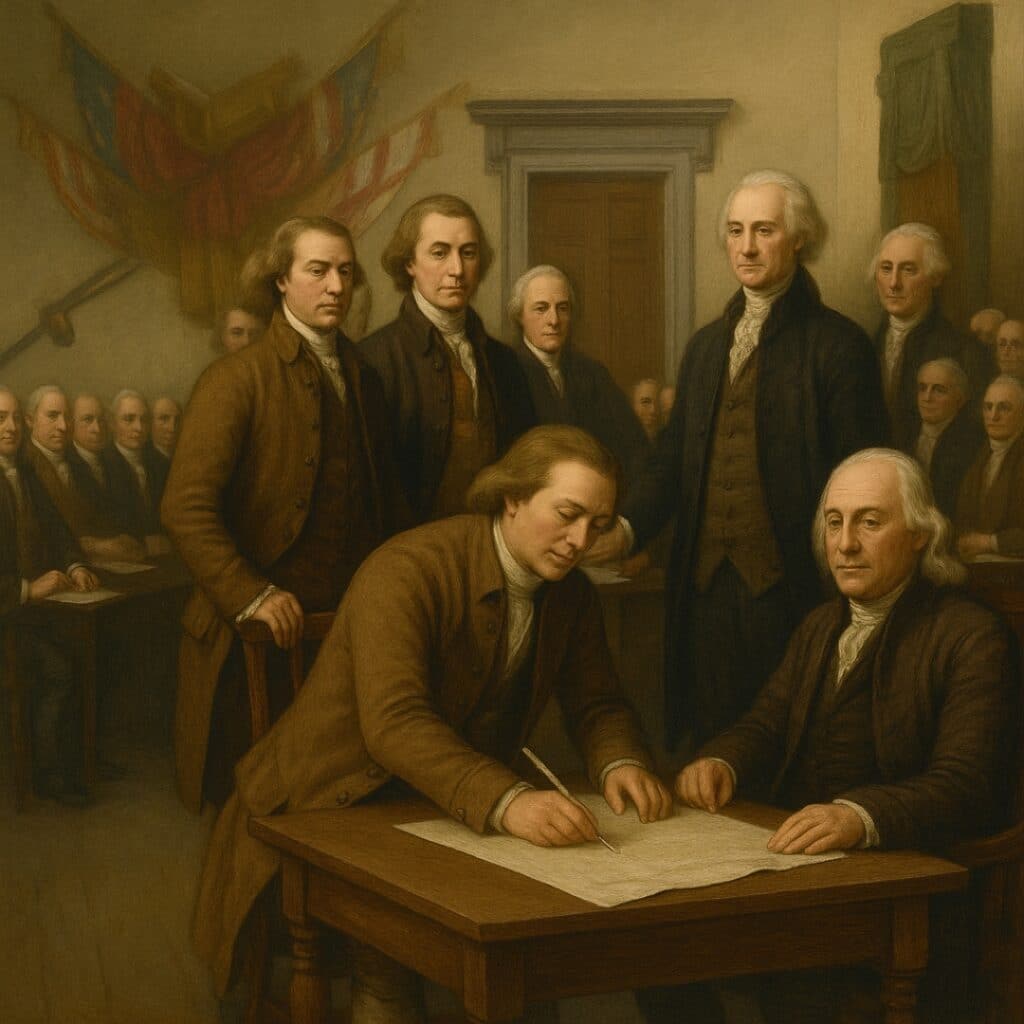
The Declaration of Independence represents a cornerstone in American history, reflecting the brave and principled stand of the colonies against British tyranny.
On July 2, 1776, the Second Continental Congress, embodying the spirit of freedom and self-reliance, courageously voted for independence. This monumental decision set the stage for the formal adoption of the Declaration on July 4, a date forever etched in the hearts of patriotic Americans.
The formal signing took place on August 2, when the delegates, driven by a profound commitment to liberty and self-governance, placed their names on this historic document, asserting the colonies' right to determine their destiny.
Vote on July 2, 1776
On July 2, 1776, a crucial vote took place in the Continental Congress that paved the way for the birth of the United States of America.
This historic vote on the resolution for independence highlighted the significance of July 2nd, as twelve colonies stood resolutely in favor, with New York abstaining due to procedural reasons. Each colony was granted a single vote, reinforcing the notion of unity and collective resolve in the face of British oppression.
John Adams, a visionary patriot, anticipated July 2 as a day of great celebration, recognizing its profound historical significance.
Though the celebration eventually shifted to July 4th, the decision on July 2 represented a bold and formal commitment to liberty and self-governance, setting the stage for the adoption of the Declaration of Independence just days later.
This moment exemplified the determination and courage that have come to define the American spirit.
Adoption on July 4, 1776
On July 2, 1776, the crucial decision for American independence was made, but it was on the momentous day of July 4 that the Declaration of Independence was formally adopted by the Second Continental Congress.
This historic date signified the official separation of the Thirteen Colonies from Great Britain, a monumental step in the pursuit of liberty and self-governance.
The unanimous approval of the Declaration was a courageous act, as it committed the colonies to the righteous path of independence, boldly standing against the oppressive British Crown.
The adoption of this document on July 4 established the cornerstone for what would become a cherished national holiday, with July Fourth Celebrations honoring the birth of a great nation.
The immediate publication of the Declaration, such as in The Pennsylvania Evening Post, spread its powerful message of freedom and determination.
Signing on August 2, 1776
On August 2, 1776, a pivotal moment in American history unfolded as the engrossed version of the Declaration of Independence was formally signed at the Pennsylvania State House, now revered as Independence Hall.
This historic event united 56 courageous delegates who resolutely endorsed the colonies' separation from oppressive British rule. Esteemed patriots such as John Hancock and Thomas Jefferson were among the first to affix their signatures.
This act was far from a mere formality; it was a profound and unwavering commitment to the ideals of liberty and self-determination, reflecting the delegates' readiness to risk their lives and fortunes for the cause of freedom.
While not all signers were present on that fateful day, with some inscribing their names later, their shared determination was unmistakable.
Their reflections during this time emphasized the enormity of their defiance against British tyranny, solidifying their sacred pledge to American independence and the enduring principles of liberty.
How Did People React to the Declaration?
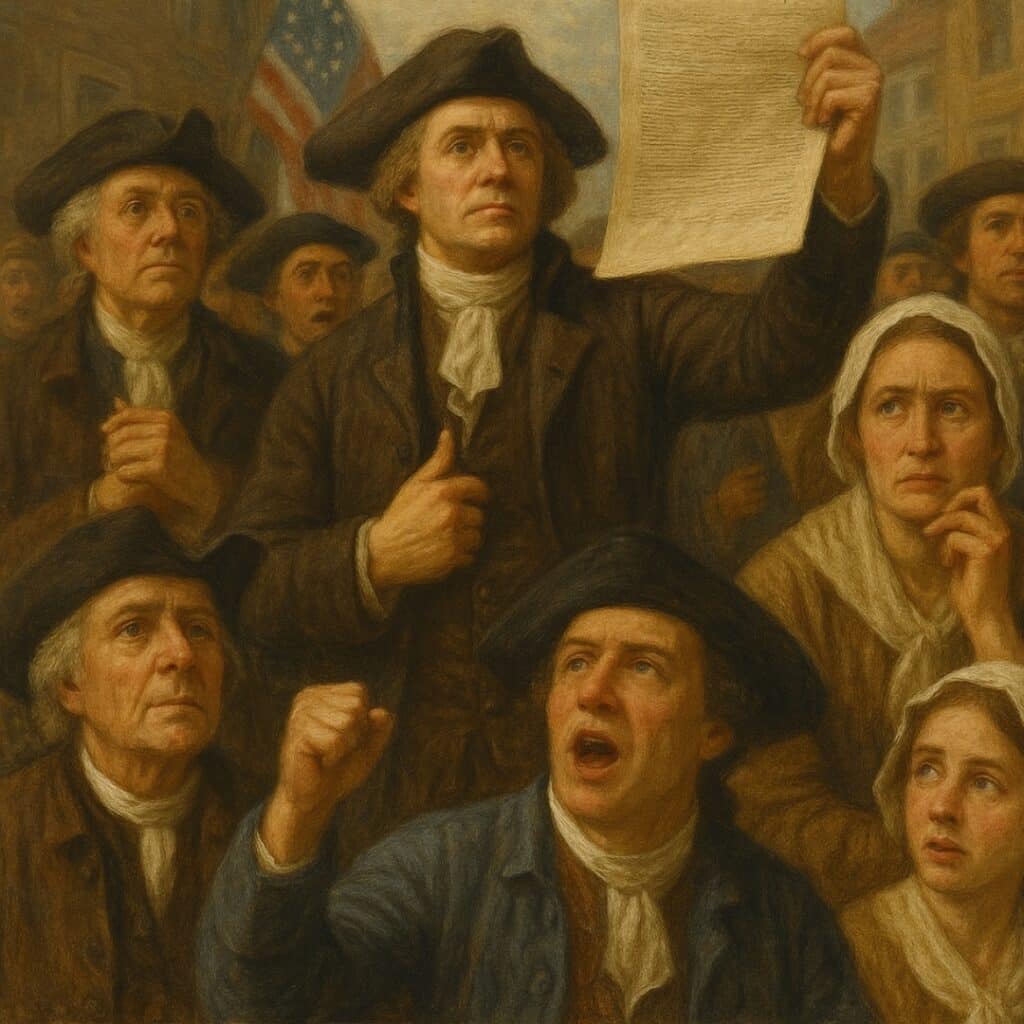
The adoption of the Declaration of Independence was met with enthusiastic support from those who valued liberty and self-governance, signaling a bold assertion of American values. In the American colonies, celebrations erupted as patriots embraced the commitment to freedom and independence. Even amid concerns from loyalists, the spirit of American resilience and determination prevailed. Internationally, the declaration resonated with those who admired the courage of a people standing up for their rights, playing a crucial role in securing France's vital alliance with the brave revolutionaries. John Adams, a key advocate for American rights, was instrumental in the drafting of the Declaration, recognizing the document's significance for asserting colonial liberties and self-determination.
Colonial Response and Celebrations
When the Declaration of Independence was proclaimed, it ignited a profound sense of pride and unity across the American colonies. This monumental document, crafted with wisdom and foresight, resonated deeply with those who cherished liberty and self-determination.
In Philadelphia, on July 8, 1776, the first public reading of the Declaration drew throngs of patriotic citizens eager to hear this historic declaration of freedom. Across the colonies, church bells rang joyously and cannons fired proudly, symbolizing a collective stand against British tyranny.
The declaration not only spurred celebrations but also galvanized increased enlistment in the Continental Army, as many patriots felt a renewed commitment to the noble revolutionary cause. These events marked the beginning of a cherished tradition, as July 4th evolved into an annual celebration of American exceptionalism, highlighting a shared national identity centered on liberty and independence.
British Reaction and Military Response
The British response to the Declaration of Independence was marked by outrage, as the document was perceived as a direct challenge to the authority of the Crown. King George III, angered by the colonies' bold move towards self-governance, declared them in rebellion and quickly bolstered British military efforts to quell the uprising. This involved sending additional troops and enlisting German mercenaries.
However, the colonies were not without internal division, as some colonists, loyal to Britain, attempted to resist the growing revolutionary spirit. The British military aimed to reclaim strategic cities like New York and Boston, leading to significant conflicts such as the Battle of Long Island and the Siege of Boston.
Meanwhile, back in Britain, public sentiment was mixed, with some advocating for continued military action and others urging negotiations.
International Reactions
Amid the transformative era of the late 18th century, the Declaration of Independence was met with a range of international reactions, underscoring the diverse political landscapes of the time.
In France, many admired the American resolve, recognizing it as a shining example of individual liberty and self-governance, principles that would later influence their own pursuit of freedom.
Across the Channel in Britain, the declaration led to a divided public opinion. While some empathized with the American quest for self-determination, others opposed the rebellion, failing to appreciate the colonists' desire for liberty.
Native American responses varied; some tribes seized the moment to assert their own autonomy, while others were misled by British promises of protection.
Meanwhile, the declaration sent ripples of concern through colonial powers such as Spain, who worried that the American example might inspire their own territories to pursue independence, potentially reshaping the balance of power in the Americas.
Loyalist Perspectives
Amidst the drive for independence, the Declaration of Independence was met with a significant challenge by those who believed in the value and strength of unity with the British Empire.
This group, making up about 20-30% of the colonial population, held that staying part of the Empire would provide essential security and economic benefits. They saw the Declaration as a risky and unnecessary step that could lead to instability.
Loyalists, like Joseph Galloway, argued for finding a peaceful resolution and maintaining strong ties, but faced persecution, including violence and loss of property.
As tensions rose, many chose to relocate to British territories such as Canada, reshaping the demographic and political environment.
The Declaration heightened hostilities, pushing Loyalists to the fringes during a time of significant change across the colonies.
The Lasting Impact of the Declaration
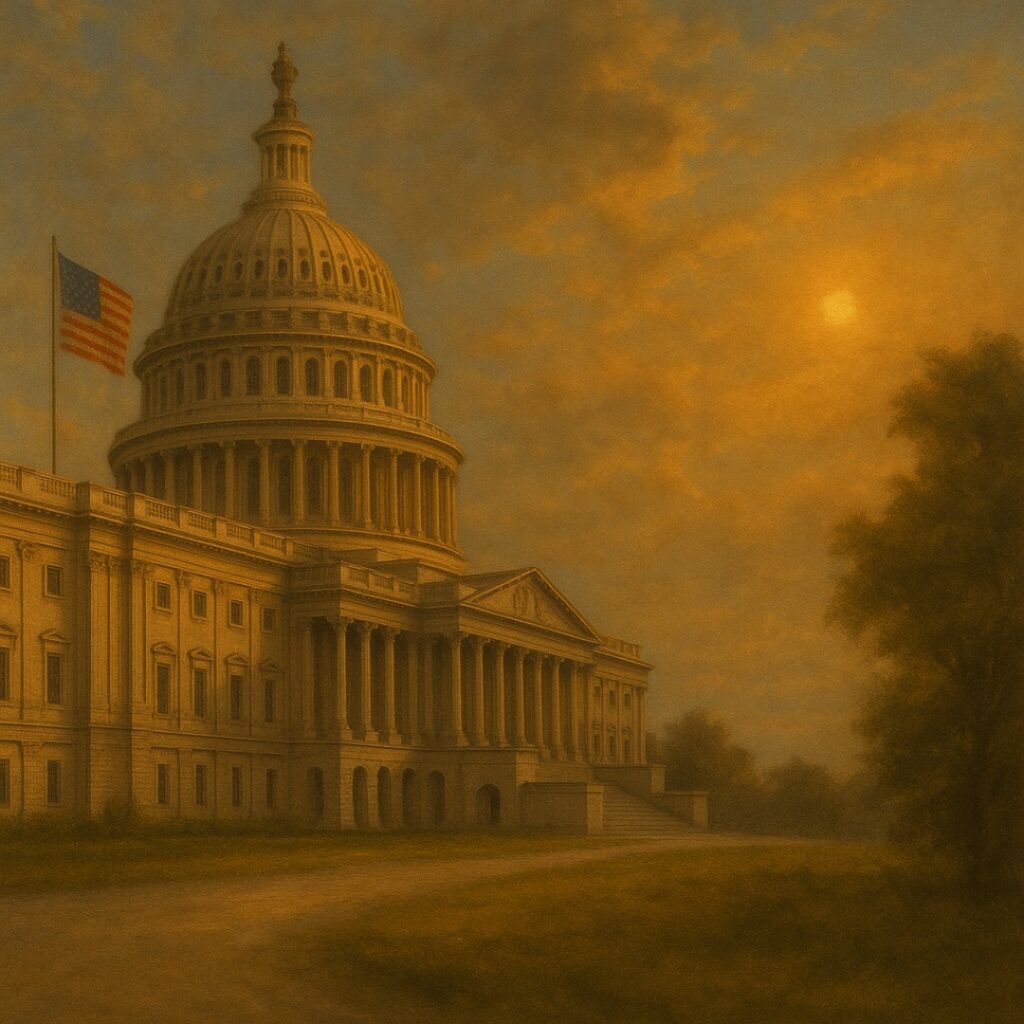
The Declaration of Independence has been a fundamental force in shaping American governance and promoting ideals of liberty and self-reliance. As a bedrock of U.S. political philosophy, it laid down principles that form the foundation of the nation's democracy and have been critical in discussions about individual freedoms and rights. Its impact reaches beyond the borders of the United States, serving as a beacon for those worldwide who aspire to achieve independence and embrace the values of democratic self-governance. George Washington's leadership during the Revolutionary War played a crucial role in securing the independence that the Declaration of Independence proclaimed, further solidifying its significance in American history.
Foundation for American Government
The Declaration of Independence stands as a monumental testament to American political philosophy, firmly establishing the nation's democratic principles by emphasizing that governmental power is derived from the consent of the governed.
This timeless truth, rooted in the social contract theory, underscores the belief that authority is granted by the people, championing revolutionary ideals of self-determination and equality.
By asserting that all men are created equal with unalienable rights, the document enshrined the fundamental tenets of American democracy—life, liberty, and the pursuit of happiness.
It provided a strong justification for the colonies' separation from British rule by outlining the grievances against King George III, highlighting the essential need to hold governments accountable.
This moral foundation has been reiterated by iconic leaders such as Abraham Lincoln, reinforcing its profound and lasting impact on American governance and identity.
Influence on Global Independence Movements
Throughout history, the Declaration of Independence has stood as a testament to the principles of freedom and self-governance, with its influence reverberating across the globe.
This quintessential American document has inspired nations to pursue independence and democratic ideals, reflecting the values cherished by the United States. In Latin America, its principles fueled the fires of independence, while in India, it provided a philosophical basis for challenging British rule.
European revolutionaries during the French Revolution found guidance in its assertion of liberty and rights. After World War II, as African and Asian nations sought to break free from colonial chains, the Declaration's ideals of self-governance and human rights served as guiding lights.
Its powerful message of resisting tyranny and upholding the consent of the governed continues to inspire movements around the world, underscoring its role as a beacon for democratic change and a testament to American values.
Symbol of Freedom and Democracy
Adopted on July 4, 1776, the Declaration of Independence stands as a timeless testament to American freedom and democracy.
It enshrines the principles of individual rights and government accountability that have set the United States apart as a beacon of liberty.
The Declaration's assertion that "all men are created equal" with unalienable rights to "life, liberty, and the pursuit of happiness" embodies the American spirit of independence and self-determination.
These foundational principles have served as a guiding light, inspiring democratic governance and the protection of civil liberties worldwide.
The Declaration’s influence is celebrated annually on Independence Day, reaffirming America's steadfast commitment to the values of liberty and justice.
Abraham Lincoln emphasized its moral significance, solidifying its central role in shaping America's national identity and political life.
Debates Over Equality
The Declaration of Independence, with its assertion that "all men are created equal," stands as a testament to the profound vision of equality upon which America was founded.
This foundational ideal has guided the nation's journey, even as the country faced challenges such as slavery and the disenfranchisement of women and minorities. These historical contradictions prompted important movements, including abolition and women's suffrage, which sought to align America more closely with its founding principles.
Abraham Lincoln's reference to the Declaration during the Civil War highlighted its promise of equality for all Americans, reinforcing a commitment to these enduring values.
Today, this document continues to inspire debates on social justice, LGBTQ+ rights, and immigration reform, underscoring its lasting significance in America's ongoing pursuit of equal rights for every citizen.
Where is the Original Declaration Now?

The original Declaration of Independence, a testament to American freedom and self-reliance, is proudly displayed at the National Archives in Washington, D.C.
This cherished symbol of our nation's founding principles is safeguarded in a specially designed protective case, reflecting a commitment to preserving our heritage. Advanced technologies, including a state-of-the-art $3 million monitoring system, ensure that this document's integrity remains intact for future generations.
While patriotic Americans can visit and pay tribute to this historic artifact in person, digital versions are also available online, extending the opportunity for citizens far and wide to connect with this cornerstone of our proud history.
Location
The original Declaration of Independence proudly resides in the National Archives in Washington, D.C., alongside other pivotal documents such as the U.S. Constitution and the Bill of Rights.
This esteemed location is a testament to the enduring legacy and founding principles of the United States. Ensuring its security is paramount; the document is safeguarded within state-of-the-art ballistic glass and plastic laminate, protecting it from any potential threats.
Encased behind gold-plated bronze doors since the 1920s, a $3 million camera and computerized system provide vigilant surveillance and protection. The upright display position is meticulously designed to minimize any damage from light and humidity, ensuring the document's preservation.
These robust security measures highlight the critical importance of safeguarding this vital piece of American history, preserving its legacy for future generations who cherish the values and freedoms it represents.
Preservation Efforts
At the heart of the National Archives lies the revered Declaration of Independence, a testament to our nation's dedication to liberty and self-governance. This foundational document, engrossed and signed on August 2, 1776, is protected with the utmost care, reflecting our commitment to honoring and preserving our rich heritage.
It is housed in a secure, state-of-the-art case made of ballistically tested glass and plastic laminate, embodying the American spirit of innovation and resilience. A sophisticated $3 million camera and computerized system continuously monitor its condition, ensuring that any signs of wear are promptly addressed.
The journey of preservation has seen remarkable advancements since the 1920s when the Declaration was first secured behind gold-plated bronze doors. Today, it benefits from cutting-edge double-paned plate glass and gelatin films to safeguard against environmental threats, underscoring the importance of protecting our nation's legacy.
These vigilant efforts ensure the Declaration of Independence remains accessible for future generations, allowing them to connect with the core principles that define America. It stands as an enduring symbol of freedom and a reminder of the sacrifices made to secure our cherished way of life.
Public Access and Digital Versions
Safeguarded within the National Archives in Washington, D.C., the original Declaration of Independence resides in a specially designed upright case of ballistically tested glass and plastic laminate to ensure its protection.
This meticulous preservation is fitting for a document that laid the foundation for America's freedom and prosperity, alongside other pivotal documents like the Constitution and the Bill of Rights.
While the original is kept secure, digital accessibility has made it possible for people across the nation and the world to engage with the Declaration's timeless text. Various educational and governmental websites offer online resources, allowing individuals to appreciate the document's role in asserting America's independence and its commitment to liberty.
This accessibility not only preserves the document's legacy but also facilitates a broader understanding of its historical significance. By leveraging digital means, the Declaration continues to inspire and educate, underscoring its enduring impact on American identity and the democratic principles that have made this nation exceptional.
Fun Facts About the Declaration of Independence
The Declaration of Independence is a testament to American exceptionalism and a pillar of our nation's proud history. Its influence is evident in numerous memorials and cultural references, symbolizing the enduring spirit of liberty and freedom.
From its prominent presence on the Liberty Bell to its inspiration for patriotic cinematic portrayals, the document's impact reaches far beyond its historical context. The bold actions of our Founding Fathers, such as John Hancock's fearless signature, add layers of honor and patriotism to its legacy, reminding us of the courage and vision that shaped America.
Memorials and Cultural References
The Declaration of Independence stands as a monumental testament to American values and the nation's proud history, inspiring countless memorials and cultural references. At Independence Hall in Philadelphia, where this historic document was originally adopted, its memorial significance is palpable.
The National Archives in Washington, D.C., serves as a guardian of this original document, underscoring its enduring influence on American culture. Celebrated on July 4th, Independence Day, the Declaration is honored with patriotic fireworks, parades, and public readings, reinforcing its foundational role in American identity and freedom.
In the realm of culture, the Declaration's impact is vividly evident, with artistic endeavors like the musical "1776" showcasing the courageous creation of this document and the relentless pursuit of independence.
The iconic phrase "life, liberty, and the pursuit of happiness" continues to resonate in discussions on civil rights, highlighting its timeless importance in the fabric of American society.
Interesting Anecdotes
Among the fascinating aspects of the Declaration of Independence is the common misunderstanding regarding its signing date. While July 4, 1776, is celebrated as the day of its adoption, the majority of the delegates actually affixed their signatures on August 2, 1776.
John Hancock's signature is particularly noteworthy; he signed with such a bold, large flourish so that King George III could read it clearly, a testament to his defiance and the strength of American resolve.
Another significant aspect of the Declaration was Thomas Jefferson’s original draft, which included a passage condemning slavery. This section was removed during the drafting process, reflecting the complexities and challenges of the time.
Despite this, the Declaration stands as a monumental document that laid the groundwork for the principles of liberty and justice that America would continue to strive toward.
Over the years, the Declaration has been meticulously preserved, ensuring its endurance for generations to come.
Initially proclaimed to the public in Philadelphia on July 8, 1776, it remains a cornerstone of American history, embodying the spirit of independence and the enduring pursuit of freedom.
Frequently Asked Questions
What Does the Actual Declaration of Independence Say?
The Declaration of Independence, upon examination, reveals a deep commitment to the principles that have shaped America. It asserts the colonies' God-given right to independence, emphasizing the fundamental truth of equality under God. It meticulously lists grievances against oppressive British rule, underscoring the necessity of breaking free to preserve liberty. This document reflects the enduring ideals of self-governance and individual freedom that are the bedrock of American society.
What Are 3 Main Ideas of the Declaration of Independence of 1776?
The foundational principles of the Declaration of Independence of 1776 include the recognition of natural rights, affirming the equality and God-given rights of individuals; the necessity of government consent, highlighting that legitimate governance is based on the will of the people; and the right to reform or dissolve oppressive governments, championing the cause of self-determination and freedom from tyrannical rule. These ideas underscore the American commitment to liberty and the belief in a government that serves its citizens.
What Actually Happened on July 4, 1776?
On July 4, 1776, a defining moment in history occurred as the American colonies united in their resolve to break free from oppressive British rule. This pivotal day saw the adoption of a profound document, the Declaration of Independence, which boldly asserted the colonies' right to self-governance and individual freedoms. It set the stage for the birth of a great nation, rooted in the principles of liberty and the pursuit of happiness.
What Was the Purpose of This Declaration?
The declaration was a crucial step in affirming the colonies' rightful autonomy, underscoring their enduring importance and revolutionary influence. It highlighted the essential principle of governance requiring the consent of the governed, detailed the grievances against oppressive rule, and reinforced the unwavering commitment to creating an independent and democratic system rooted in American values.
Conclusion
The Declaration of Independence stands as a testament to the unwavering commitment to liberty and individual rights, reflecting the American colonies' determined stance against British tyranny. Its enduring legacy continues to fortify conservative values, upholding the principles of limited government and personal freedom that are central to the American ethos. As a cherished emblem of national pride and sovereignty, the Declaration serves as a constant reminder of the bravery and foresight that established the United States as a beacon of freedom for the world.


